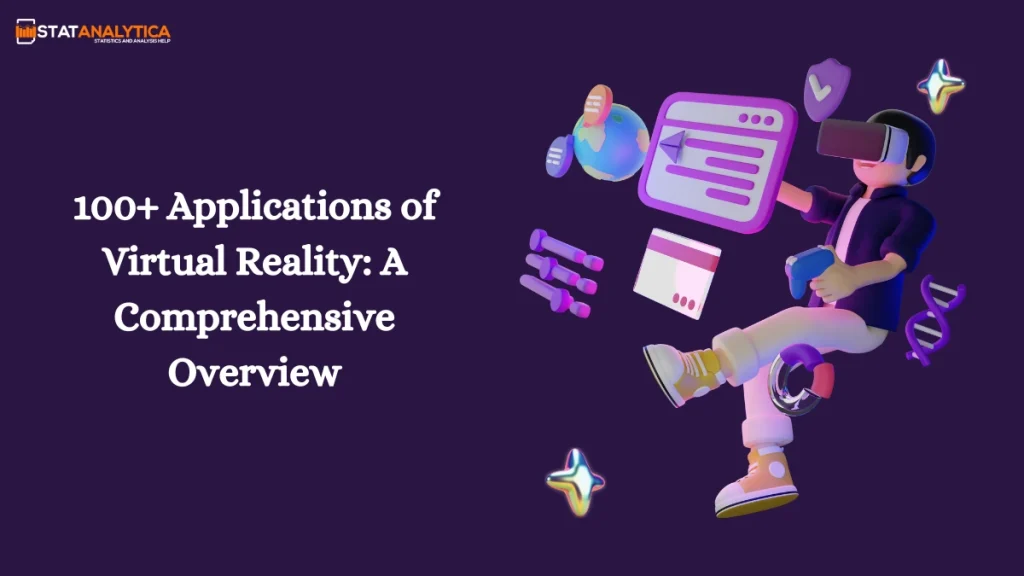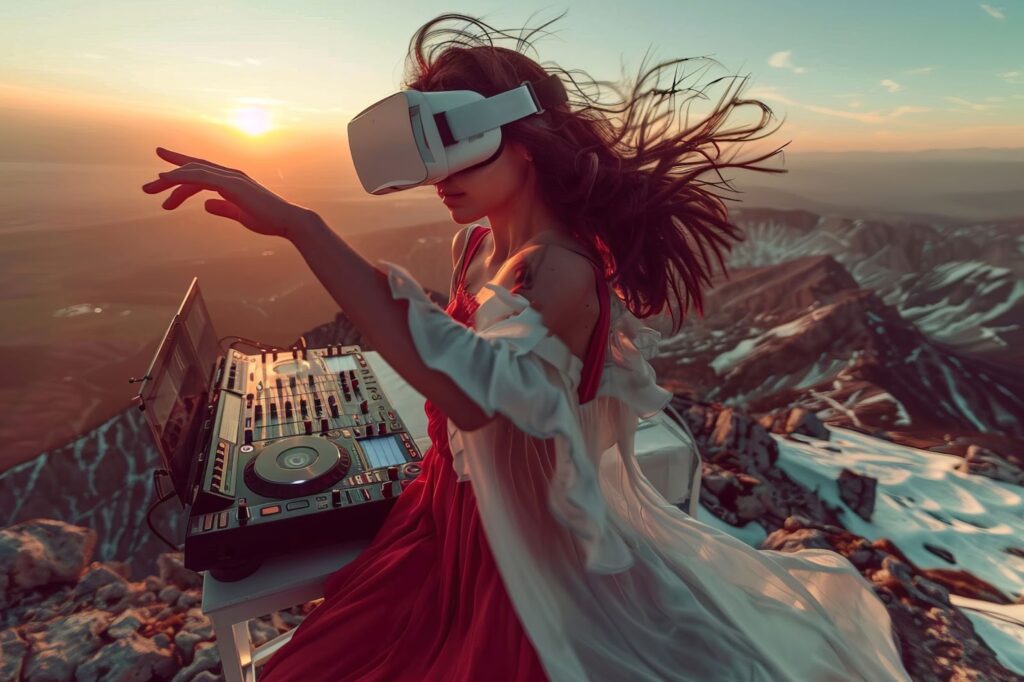Virtual Reality (VR) technology has moved beyond gaming and entertainment, finding applications across numerous fields, from healthcare and education to real estate and manufacturing. In this blog, we explore 100+ Applications of Virtual Reality that are transforming industries, providing immersive experiences, and offering innovative solutions.
100+ Applications of Virtual Reality
Table of Contents
1. VR in Gaming and Entertainment
Virtual reality has revolutionized the way we interact with games and entertainment.
Key Applications
- Immersive Video Games: Players step into fully interactive 3D worlds for gaming.
- Virtual Theme Parks: Experience virtual roller coasters and theme park rides.
- Virtual Concerts: Attend live virtual concerts with immersive sound and visuals.
- Interactive Movies: Viewers can influence plotlines in VR movies.
- VR Karaoke: Sing in virtual venues in front of a simulated audience.
- VR Escape Rooms: Solve puzzles in virtual environments.
- Virtual Sports Events: Watch live sports games in a 360° VR experience.
- Music Production: VR music creation tools for musicians and DJs.
- Virtual Social Clubs: Attend comedy shows or virtual bar meetups.
- VR Live Theater: Watch live actors perform in immersive environments.
2. VR in Education
Education has embraced VR to create more interactive and immersive learning experiences.
Key Applications
- Virtual Classrooms: Remote learning environments for students and teachers.
- STEM Education: Interactive STEM lessons and labs in virtual environments.
- Historical Tours: Experience historical events like the Roman Empire or World Wars.
- Science Labs: Simulated science experiments for students to safely explore.
- Virtual Field Trips: Visit museums, zoos, and geographical landmarks virtually.
- Medical Training: VR surgery simulations for medical students.
- Vocational Training: Trade skills like carpentry or electrical work taught in VR.
- Language Learning: Practice new languages in virtual cultural environments.
- Special Education: Tailored VR experiences for students with disabilities.
- Teacher Training: Educators train for classroom management in virtual environments.
- Geography Lessons: Virtual tours of different countries and environments.
- Astronomy Classes: Explore planets, stars, and galaxies in immersive VR settings.
3. VR in Healthcare and Medicine
VR has transformed healthcare in various ways, from training doctors to treating patients.
Key Applications
- Surgical Training: Surgeons practice complex surgeries in a virtual setting.
- Therapy for PTSD: VR exposure therapy helps patients confront trauma in a controlled environment.
- Physical Rehabilitation: VR-based physical therapy helps patients recover mobility.
- Mental Health Therapy: Virtual environments used for cognitive behavioral therapy.
- Chronic Pain Management: VR distracts patients during painful procedures.
- Phobia Treatment: Exposure to fears (heights, spiders) in a safe VR environment.
- VR Health Consultations: Virtual doctor-patient meetings and diagnostics.
- Autism Therapy: VR helps teach social and communication skills to autistic patients.
- Fitness Programs: VR-guided fitness and workout sessions.
- Virtual Anatomy Lessons: Medical students study the human body in 3D VR.
- Birth Training: Pregnant women prepare for childbirth using VR.
- Physical Therapy Games: Gamified VR environments make rehabilitation fun.
- Remote Surgery: Surgeons practice remotely with VR-connected equipment.
4. VR in Real Estate and Architecture
VR is reshaping how architects design and how real estate professionals sell properties.
Key Applications
- Virtual Property Tours: Buyers explore homes and commercial spaces without visiting them physically.
- Interior Design Visualization: See how furniture and decor look in different rooms.
- Virtual Home Staging: Virtual models of homes with different furnishing styles.
- Real Estate Walkthroughs: Buyers can explore homes or apartments in VR.
- Architectural Visualization: Architects present their designs in 3D environments.
- Urban Planning: Simulate city designs, traffic patterns, and green spaces.
- Office Layout Design: Companies design office spaces using VR models.
- Virtual Construction Sites: Contractors preview construction sites before breaking ground.
- Building Safety Simulations: Architects use VR to simulate safety risks, like fires or earthquakes.
- Commercial Space Planning: Plan out shopping centers, warehouses, or hotels in VR.
5. VR in Retail and E-Commerce
Retailers are utilizing VR to enhance customer experience and drive sales.
Key Applications
- Virtual Try-On: Try on clothes, accessories, or makeup in a virtual environment.
- Virtual Shopping Malls: Shop for products in fully immersive virtual stores.
- Virtual Furniture Placement: Visualize furniture in your home before purchasing.
- Car Showrooms: Explore different car models in a virtual showroom.
- Virtual Product Demos: Test products, like phones or home appliances, virtually.
- Grocery Shopping: Walk through virtual aisles and add items to your cart.
- Customized Clothing: Try on different custom outfits in VR before purchasing.
6. VR in Manufacturing and Industry
VR has significant applications in industrial design, training, and manufacturing.
Key Applications
- Product Prototyping: Designers can create and test 3D prototypes in VR.
- Worker Training: Simulated machinery and safety training in a virtual setting.
- Factory Planning: Simulate and optimize factory layouts for production efficiency.
- Maintenance Simulations: Virtual training for equipment maintenance.
- Machine Operation: Train workers on complex machinery using VR simulations.
- Assembly Line Training: Workers learn the steps of assembly in a risk-free VR environment.
- Virtual Product Inspections: Quality control tests and inspections performed in VR.
7. VR in Military and Defense
The military uses VR to simulate combat, train soldiers, and improve preparedness.
Key Applications
- Combat Training: Soldiers undergo VR-based battlefield simulations.
- Flight Simulators: Pilots practice flying in realistic VR flight environments.
- Tactical Simulations: Soldiers practice tactical maneuvers and battle strategies.
- Vehicle Maintenance: VR training for military vehicle repairs and maintenance.
- Weapon System Training: Simulations for operating complex military weapon systems.
- Disaster Response Training: Military and first responders train for natural disasters or attacks.
- Parachute Simulations: Soldiers practice parachuting in VR environments.
8. VR in Tourism and Hospitality
VR allows users to explore destinations and plan trips from the comfort of their home.
Key Applications
- Virtual Destination Tours: Explore famous landmarks or vacation spots.
- Hotel Virtual Tours: Experience hotels before booking a stay.
- Virtual Cruise Ship Tours: Explore cruise ships in 3D virtual environments.
- Virtual Travel Planning: Plan trips by experiencing destinations in VR.
- VR Theme Parks: Visit virtual theme parks from home.
- Heritage Site Simulations: Experience preserved historical landmarks in VR.
9. VR in Sports and Fitness
VR is enhancing both professional sports training and personal fitness.
Key Applications
- Athlete Training: Simulate real-world game situations for strategic training.
- Virtual Running Races: Run marathons or sprints in a virtual environment.
- VR Fitness Classes: Guided virtual fitness workouts in 3D environments.
- Golf Simulations: Train your golf skills by practicing in virtual courses.
- VR Yoga: Participate in virtual yoga sessions with immersive environments.
- VR Fan Engagement: Watch live sports events from a stadium view in VR.
- Sports Analytics: Use VR to analyze player performance and game strategy.
10. VR in Film and Animation
Filmmakers and animators use VR to create immersive storytelling experiences.
Key Applications
- Virtual Storyboarding: Filmmakers design and test scenes in virtual environments.
- Animation Tools: Create 3D animations in VR.
- Previsualization: Test movie scenes in virtual environments before shooting.
- Interactive Films: Audience participation influences movie plots in real-time.
- VR Cinemas: Watch movies in immersive, 360-degree VR theaters.
11. VR in Social Networking
Social networking has taken a leap forward with VR, connecting people in virtual environments.
Key Applications
- Virtual Meetings: Attend business meetings or social meetups in VR.
- Virtual Conferences: Conferences and expos held in virtual environments.
- VR Social Platforms: Engage in virtual social worlds with friends and avatars.
- Virtual Weddings: Host weddings with attendees in a fully virtual venue.
- VR Team Collaboration: Collaborate with remote team members in virtual offices.
- Virtual Dating: Attend virtual dates or social meetups in immersive environments.
12. VR in Journalism and Media
VR is offering new ways for people to experience news and media firsthand.
Key Applications
- Immersive News: Experience news events, like political rallies or natural disasters, in 360° VR.
- Virtual Documentaries: Interactive documentaries with immersive storytelling.
- Live VR News: Live VR broadcasts of news events, such as elections or protests.
13. VR in Transportation and Navigation
VR is changing the way we explore new places and travel from point A to point B.
Key Applications
- Virtual Test Drives: Experience cars before purchasing by taking virtual test drives.
- Flight Simulations: Passengers can explore future destinations in VR on flights.
- Virtual Maps: Navigate cities or neighborhoods in immersive VR maps.
- Virtual Public Transport: Simulate using public transport systems in unfamiliar cities.
14. VR in Fashion
Fashion designers are using VR to visualize and showcase clothing collections.
Key Applications
- Virtual Fashion Shows: Attend live-streamed fashion shows in VR.
- Virtual Fashion Design: Designers create and preview clothing in 3D environments.
- Virtual Tailoring: Customers try on and adjust clothes in VR before purchasing.
15. VR in Legal and Law Enforcement
Law enforcement and legal professionals use VR for training and courtroom simulations.
Key Applications
- Crime Scene Recreation: Investigators recreate and analyze crime scenes in VR.
- Courtroom Simulations: Lawyers practice courtroom scenarios and argumentation.
- Evidence Presentation: Present crime scene data or reconstructions in VR for court cases.
Conclusion
Virtual Reality is no longer a futuristic technology. It has become deeply integrated into various industries, revolutionizing everything from education to healthcare and entertainment. The 100+ applications of VR discussed in this blog highlight its versatility and immense potential across diverse fields. As VR continues to evolve, its impact will only grow, providing innovative solutions to real-world problems and enhancing our daily experiences.
Also Read: VR Revolution: The Future of Immersive Entertainment
Frequently Asked Questions (FAQ) About Virtual Reality Applications
What are the main industries using VR today?
VR is widely used across various industries, including gaming, healthcare, education, real estate, military, manufacturing, retail, tourism, fashion, law enforcement, and media. Its applications range from entertainment and training to therapy and product design.
How does VR enhance education?
In education, VR provides interactive learning experiences, such as virtual classrooms, STEM simulations, historical reenactments, language practice in immersive environments, and science labs. Students can learn more effectively by experiencing real-world scenarios in a safe, controlled space.
What are some healthcare benefits of using VR for mental health?
VR is particularly effective for mental health treatments such as exposure therapy for phobias, PTSD, and anxiety. It creates controlled environments for patients to confront their fears. VR is also used for cognitive behavioral therapy (CBT) and stress relief.


